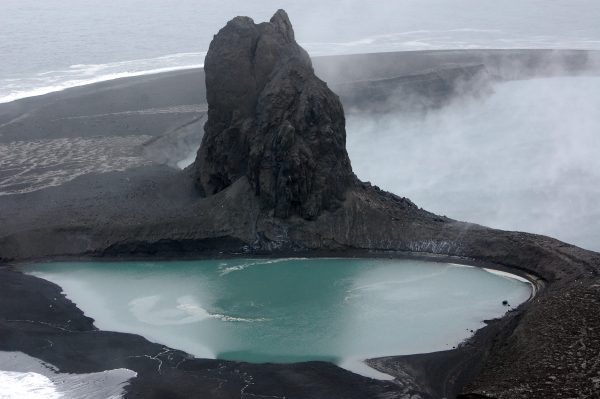Text messages alert researchers to Bogoslof eruptions
July 6, 2017
Sue Mitchell
907-474-5823

For most of us, the tri-tone jingle emanating from our cellphone signals a text message from a friend, or maybe an incoming email. But for University of Alaska Fairbanks Geophysical Institute researchers and colleagues working with the Alaska Volcano Observatory, that familiar tone may be the first sign of a volcanic eruption.
Bogoslof is a remote volcano, 835 miles southwest of Anchorage in the Aleutian Islands, that has been erupting since December. To keep tabs on this now six-month-long eruptive event, AVO has vastly increased automated alarms. Now when signs of an eruption are detected, that information is broadcasted directly to AVO researchers’ phones as text messages.
“Bogoslof is more remote and has less human impact than some other Alaska volcanoes, so alarms have been sufficiently reliable for monitoring,” said UAF geophysics professor and AVO coordinating scientist Jeff Freymueller.
When Mount Redoubt erupted in 2009, monitoring the volcano required that scientists be in an operations room 24 hours a day, said David Fee, an AVO researcher and research associate professor at UAF’s Geophysical Institute.
“Now, we can respond from home about as easily as we can from work,” said Fee.
Fee and Freymueller are two of a handful of researchers who receive alerts at the first sign of an eruption. If sensors near Bogoslof pick up any unusual seismic or infrasound activity, or if lightning is recorded near the island, both researchers are notified. From that point, they can work to determine if Bogoslof is actually erupting.
“The messaging system has actually gone from things that researchers were fiddling with to something actually used and tested,” said Freymueller.
The quick response to the alarms has evolved since the first eruption in December. At first, researchers would communicate through text message chains, a system that was simple but left anyone not added to the initial text out of the loop. To create a more accessible response system, AVO members at the GI started using a message-board app called Mattermost.
When using this app, “if you get back from the gym and look at your phone and say, ‘Oh my gosh, Bogoslof’s erupting,’ you can look back at what was written 20 minutes ago,” said Freymueller.
Freymueller cites the new communication systems as one of the most important learning experiences from the string of Bogoslof eruptions.
“Our tools for monitoring and response are definitely being sharpened by this event,” said Freymueller.
With over 50 eruptions since December, the challenges surrounding monitoring Bogoslof have become almost common knowledge. For one, because Bogoslof Island is so remote and entirely formed by the volcano, it is impossible to house monitoring equipment at the site.
“Alaska volcano monitoring is always more challenging, and Bogoslof is even more so,” said Fee.
The lack of monitoring devices makes it especially tricky to predict when Bogoslof will erupt.
“We would like to be more advanced in our forecasting system,” said Fee. “A lot of the time, it's just boom — eruption.”
That is not to say the researchers do not work to keep up with the signs of an impending eruption. For a while, scientists at AVO were able to observe patterns that predicted a Bogoslof eruption, according to Freymueller. But “I don't think we've actually seen that pattern for at least three months now,” he said.
GI research assistant professor and AVO member Taryn Lopez has also noticed unusual patterns while monitoring Bogoslof. Lopez, who specializes in volcanic gases, has observed that sulfur dioxide has only been detected from about half of the Bogoslof eruptions, and even then, the amount is much less than the average volcano.
For Lopez, this observation means that the recent string of Bogoslof eruptions can be a valuable learning opportunity. In further research, she will investigate why Bogoslof has such low sulfur dioxide emissions by comparing the volcanic gas data with other eruption indicators.
“We can apply that knowledge to other submarine volcanoes,” said Lopez.
Though researchers are now envisioning how the data collected from the Bogoslof eruptions will be analyzed in the future, real-time monitoring may continue to keep the group occupied. According to Freymueller, past Bogoslof eruptions have lasted up to two years, and there is no indication that this eruption event is ending any time soon.
“It’s really increased everyone’s workload,” said Lopez.
Because AVO researchers work for the Geophysical Institute, the U.S. Geological Survey, and the State of Alaska Division of Geological and Geophysical Surveys, many experts and departments share the responsibility of monitoring Bogoslof, which helps avoid burnout, Freymueller said.
“Being able to actually spread the workload around is a big, big help,” said Freymueller. “Having enough people that you don’t drive a few people crazy is really necessary.”
However, the group acknowledges that when monitoring a volcano like Bogoslof, experience can be extremely valuable.
“We have been pretty successful in general in catching the onset of the eruption and responding pretty quickly,” said Freymueller. “Once you have been through 30 of these explosions, you have probably seen most of the patterns.”


